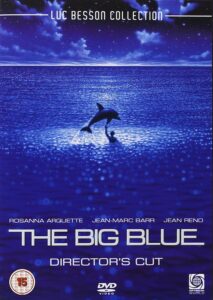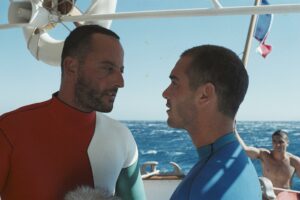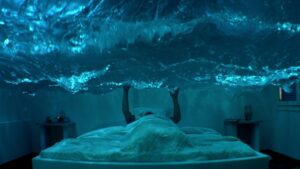“The Big Blue” – On the Bourder of the Worlds

Title: “The Big Blue”
Release Date: 1988
Director: Luc Besson
Cast: Jean Reno, Rosanna Arquette, Jean-Marc Barr, Paul Shenar
“The Big Blue” is the undisputed masterpiece of Luc Besson, which turned out to be a spectacular international success. The film strongly influenced the young generation of the 1990s and became a cultural phenomenon. Inspired by the story of the friendship and rivalry of Jacques Mayol and Enzo Maiorca, young people began to practice diving en masse and attempt to break sea records. “The Big Blue,” however, is a picture that not only grows out of a great love for the water world, but also opens up a space of metaphorical meanings: from confronting psychological trauma to metaphysical meanings.
“The Big Blue” – dangerous depths
“The Big Blue” of 1988 was a huge success for Luc Besson. The French director made the film in English, as he later did with his other big blockbuster “Leon: the Professional”. The picture’s script was loosely based on the true story of two divers: Jacques Mayola and Enzo Maiorca (in the film he bears the name Molinari), who competed against each other in breaking the freediving record. The role of Mayola was played by Jean-Marc Barr, and Enzo was played by Jean Reno. The film presents the fate of two men who fell in love with the sea while they were still children and began to compete with each other.
Mayol as a teenage boy has to face the tragic experience of the death of his father, who drowns in front of his son. Years later, as an adult, he takes part in scientific experiments on human physiology in Peru, where he dives under the ice. There he meets Joanna Baker (Rosanna Arquette), an American insurance agent who quickly falls in love with him. Soon Mayola, after years of silence, finds Enzo to invite an old acquaintance to an international diving competition in which he has long been a champion. An increasingly dangerous rivalry begins between the men.

Although Jacques bonds with Joanna, his heart belongs to the ocean and the dolphins he can talk to. When Enzo, in spite of warnings, loses his life while beating another record, Jacques makes the decision to go to the bottom of the sea. Not even the news that Joan is expecting his child stops him from doing so.
“The Big Blue” – Besson as a painter of nature
“The Big Blue” by Luc Besson is a magnificent display of filmmaking abilities in showing the power of natural elements. Shots were taken in a great many places: in Sicily, the French Riviera, Corsica, Paris, New York, the Bahamas, Greece, Peru and the Alps. The author of the amazing pictures is the incomparable Carlo Varini. The technique of photography co-creates in the film “The Big Blue” terms of meaning. It is worth noting, for example, that the movie begins with black-and-white shots – in this way the childhood stage of Enzo and Jacques is shown as an irretrievably past. In turn, when we see the characters as grown men, brilliant colors appear.
An important role is played by shots shot from a fast-moving helicopter over the water, which makes the whole picture extremely realistic, and at the same time, by means of contrast with underwater shots, signals the film’s key opposition of surface and depth. This opposition even becomes apparent in the construction of the two protagonists, one of whom is an extrovert (Enzo) open to the outside world and its charms, and the other an introvert (Jacques) locked in the mysterious depths of his mind.
Of course, Eric Serra’s phenomenal music with the main theme “The Big Blue Overture” also plays an important role. Underwater shots are illustrated by music imitating the sounds of the deep and dolphins, while the local atmosphere of South America is reflected by ethnic elements, and cultural associations with the US are signaled by hip-hop-like rhythms. It is not without reason that “The Big Blue” was awarded the Caesars precisely for music and sound.

The psychoanalysis and mystique of “The Big Blue”
“The Big Blue” certainly suggests deeper than literal possibilities of interpretation. In the story presented by Luc Besson one can see not only a tale of the danger of competition and the ambivalent face of every passion. It seems that one of the keys used to open the film is psychoanalysis. In this context, the character of Jacques measuring himself against childhood trauma is particularly significant. Extremely significant is the first scene in which we see him as a grown man: Jacques dives into the ice-covered depths. He is separated from the surface by thick walls of frozen water, symbolizing his extreme isolation from the world. The act of diving itself can refer to Jacques’ attempts to confront his trauma, and the protagonist’s final decision to stay at the bottom to his complete mental breakdown and absorption by the trauma.
The depths of the seas and oceans in “The Big Blue” also have mystical aspects. Following Mircea Eliade’s theory, we can say that we are dealing here with a group of aquatic myths, which include, for example, the biblical flood, the act of baptism or the story of the sea monster Leviathan. Water symbolizes a state of peculiar potentiality and unformability. The descent into the sea depths can be read as the act of returning to the state before birth – fetal waters. It is also symbolic of death, while the ascent signifies birth and the act of creation.
Water is an almost transcendent element in “The Big Blue,” evoking both awe and fear. Diving into the depths with breath held and heart rate slowed down grows here into a borderline and mystical experience. It is a balancing act on the border between two worlds, which can be both wonderful and deadly at the same time. It represents an irresistible temptation like the deceptive voice of beautiful sirens luring you astray.
Literature:
Janet Maslin, „Rival Divers Brave the Depths of the Sea”, „The New York Times” August 1988, , section 1, p. 11
Tomek Rokita, „Big Blue, the (Wielki błękit)”, filmmusic
